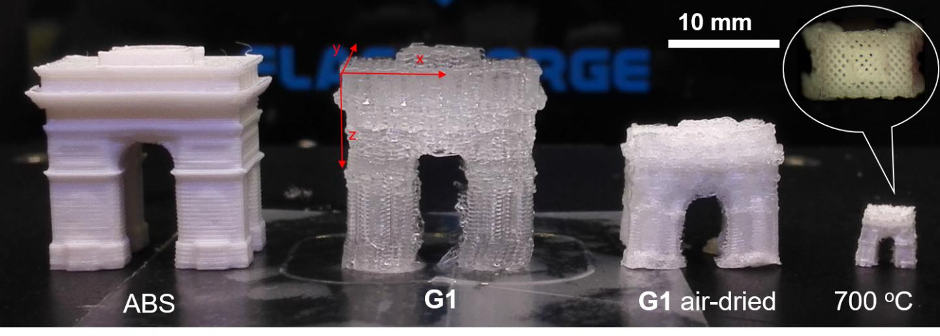
3D-printed object composed of hydrogel (G1) can change size after printing (Chenfeng Ke)
The innovation from Dartmouth College, New Hampshire promises to add more functionality to 3D printing and could pave the way to a new generation of printed material.
The advance in form-changing intelligent printing - or 4D printing – is claimed to provide a low-cost alternative to printing precision parts.
"This technique gives life to 3D-printed objects," said Chenfeng Ke, an assistant professor of chemistry at Dartmouth. "While many 3D-printed structures are just shapes that don't reflect the molecular properties of the material, these inks bring functional molecules to the 3D printing world. We can now print smart objects for a variety of uses."
Many 3D printing protocols rely on photo-curing resins and result in hard plastic objects with rigid, but random molecular architectures. According to Dartmouth, the new process allows designers to retain specific molecular alignments and functions in a material and converts those structures for use in 3D printing.
By using a combination of new techniques in the pre-printing and post-printing processes, researchers were able to reduce printed objects to one per cent of their original sizes and with 10-times the resolution. It is further claimed that the 3D printed objects can be animated to repeatedly expand and contract in size through the use of supramolecular pillars. With fluorescent trackers, the objects can be made to change colour in response to an external stimulus such as light.
The ability to reduce the size of an object after printing while preserving functional features and increasing resolution allows inexpensive printers to print high-resolution objects that were once only possible with much more sophisticated printers.
According to the study, which was selected as a VIP paper by Angewandte Chemie, the smart ink can print at a rough, 300-micron resolution, but the end product would feature a much finer line width of 30 microns.
"This process can use a $1,000 printer to print what used to require a $100,000 printer," said Ke. "This technique is scalable, widely adaptable and can dramatically reduce costs."
To create the smart ink, researchers used a polymer-based vehicle that integrates intelligent molecular systems into printing gel and allows for the transformation of their functions from the nanoscale to the macroscale.
While most materials are readily hardened during the 3D printing process, the new process introduces a series of post-printing reactions which lock the active ingredients together and retain the form of the molecular structure throughout the printing process.
The result is a printed object with a molecular design that can transform itself depending on the stimuli applied to it.
"Not only can we 3D print objects, we can tell the molecules in those objects to rearrange themselves at a level that is viewable by the naked eye after printing,” Ke said. “This development could unleash the great potential for the development of smart materials.”
Whilst still some distance from intelligent 3D systems that can dynamically change their configuration, the technology could be used to print precision filters and storage devices. Over time, researchers expect that the process could result in a new class of macroscale 3D printed objects that can be used to deliver medicine or produce high resolution bone replacements.










McMurtry Spéirling defies gravity using fan downforce
Ground effect fans were banned from competitive motorsport from the end of the 1978 season following the introduction of Gordon Murray's Brabham...